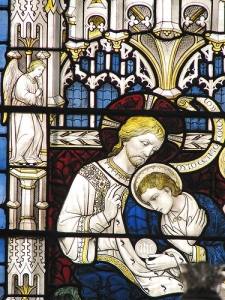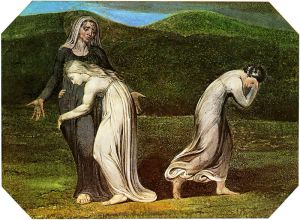The story of Ruth and Naomi is widely quoted by queer writers as an example from Scripture of possible lesbian love: but how relevant is it? Superficially at least, it is just a simple story of exceptionally strong family affection and loyalty, between mother- and daughter- in-law. Whether in any way “lesbian” or not, the story is relevant, but not perhaps in the way usually told. To unravel the lessons it may hold for us, let’s begin with the simple story.
Naomi was an Israelite widow, living for a while (on account of famine) in Moab, where she married her two sons to Moabite women, Orpah and Ruth. The sons later died, leaving Naomi “all alone, without husband or sons” ,
She did have two daughters-in-law, and when she heard that conditions back in Israel had improved, she returned, initially taking her two daughters-in-law with her. She then had a change of heart, and encourages the two women to return to their own home in Moab. After some persuasion, Orpah did so, but Ruth refused.
Do not press me to leave you
Or turn back from following you!
Where you go I will go,
Where you lodge, I will lodge;
Your people will be my people, and your God my God.
Where you die, I will die –
There will I be buried.
May the Lord do thus and so to me,
and more as well,
if even death parts me from you.
(Ruth 1: 16-17)
After their arrival in Bethlehem, Naomi arranged a second husband for Ruth, to Boaz. She then bore a grandson for Naomi, a grandson who would support them both in old age, and who would in time be part of the lineage linking Naomi to David, and hence to Jesus. (Ruth becomes King David’s great-grandmother: Ruth is the mother of Obed, who is father of Jesse and grandfather of David.)
It is obvious from the above that Naomi was mother-in-law to Ruth –twice over. It is equally obviously a story of great affection and loyalty between two women. Is it more?
John Boswell doesn’t think so:
“There is little in the Book of Ruth to suggest that anything other than loyalty bound Ruth to Naomi (who had, in fact, suggested that Ruth depart, along with her other daughters-in-law; but Ruth refused to do so.)”
He also points out that the obvious devotion of Ruth to Naomi is instrumental in securing the attention of Boaz. What would be the point of remembering a lesbian relationship that serves to attract a husband for one of the women?
Paul Halsall asks, but does not answer, the question,
Is this a story about Lesbianism, which was not forbidden at all in the Law? Whatever the answer, it is a story of love and loyalty between two women.
However, he does point to another aspect of the story which is less commonly remarked on, that it is a story of the outsider, and how outsiders can become insiders. As a Moabite woman, Ruth is very much an outsider in Israeli society. Yet she accepts this in her loyalty to Naomi, and is ultimately rewarded by becoming the mother of Obed, the grandmother of King David, and ultimately an ancestor of Jesus himself.
This is a book of the inclusivity of God's call, and another Biblical illustration of the limits of the Law
Paul Glaser also sees this as a story of devotion, but reads it as a “coming out” story:
All of us who grow to accept and affirm our sexuality have in some sense heard this call to come out. In grief and regret, some of us may feel forced to leave a family, a congregation, or a community (much as Ruth did) to make our commitments. Following Ruth and Naomi’s strategy, we may use whatever is available to us in the church and society to survive. Yet, alongside Ruth and Naomi, we use our commitment to lovers, our fresh understandings of God, and our new communities of faith – maybe a support group, a network, an organization, a congregation - to survive.
A comment placed on this site by a Baptist pastor ( “ hinbww ”) responding to an earlier article on the Bible (Is the Bible Anti-gay?"), stated unequivocally:
Ruth & Naomi were married.
He later elaborated:
Ruth 1:14, referring to the relationship between Ruth and Naomi, mentions that “Ruth clave onto her.” (KJV) The Hebrew word translated here as “clave” is identical to that used in the description of a heterosexual marriage in Genesis 2:24: ” Therefore shall a man leave his father and his mother, and shall cleave unto his wife: and they shall be one flesh.” (KJV)
This book was probably included in the Hebrew Scriptures because King David was one of the descendents of Ruth. Although this same-sex friendship appears to have been very close, there is no proof that it was a sexually active relationship.
How valid this interpretation is, I have no idea. I have no knowledge of Hebrew, but if the word used in Ruth 1:14 is the same as that in Genesis 2:24, as stated, then the suggestion is an important one which needs to be taken seriously. It is also worth pointing out though, that Naomi’s arrangement of a marriage to Boaz does not eliminate the possibility of a lesbian relationship between the two women; and that a lesbian relationship does not necessarily imply a sexual relationship. (We recognise a number of gay clergy as saints who clearly demonstrate a homosexual orientation, and who had deeply intimate emotional relationships with men, who are nevertheless accepted as having remained celibate).
What do I think?
I don’t see the need for just a single, "correct" interpretation. I think the reading of “cleave” suggested above is worth taking seriously and one which I will try to explore further. I also think it is worthwhile to use the passage as a reflection on female loyalty, or on inclusion and outsiders, or on coming out. But I also see this passage in another light, which is instructive but not inspirational.
When I read Ruth as a gay man, I am struck by another theme entirely how totally dependent women of that time were on men, for their very survival. When Naomi’s sons died, she is described as being left all alone. She was not – she had two daughters in law, but they didn’t count. Much later, during the negations leading up to the marriage of Ruth to Boaz, there is a complicated bit about the sale of a piece of land. The critical point is that the purchaser of the property is obliged to take the woman with it – women are sold as property along with the land, The joyful climax of the story is the birth of a son, who can take care of both women in their old age,
This reminder of the total dependence of women on men goes to the heart of the problems of the church on matters of gender and sexuality. Women continue to be seen as inferior to men, and are treated accordingly. The inferior status is also why the Leviticus prohibition is on men who lie with men “as with women”, and why so many societies, then and now, see it as shameful for a man to take the “female” part in male intercourse, but to take the “masculine”, active, role, is not regarded as gay at all. These attitudes , coupled with some bizarre ides about animal behaviour, were behind the condemnation of same sex relationships by some (not all) early church fathers.
The social attitudes of Jewish society revealed by the story of Ruth and Naomi are at the heart of the modern oppression by the church of women and gay men. Ruth and Naomi found a way to survive and flourish working within the system. For us today, in a world where the attitudes outside the church (informed by science and reason) are very different, should not have to work within an unjust system to flourish ourselves. Instead, we should work to subvert and destroy those elements that are unloving and unjust.
Kittredge Cherry has also written on these two: see
Jesus in Love blog
references:
John Boswell, Same Sex Unions in Pre-Modern Europe, (Harper-Collins)
Chris Glaser, Coming out as Sacrament (Westminster John Knox Press)
Paul Halsall, Calendar of LGBT Saints (on-line)

















